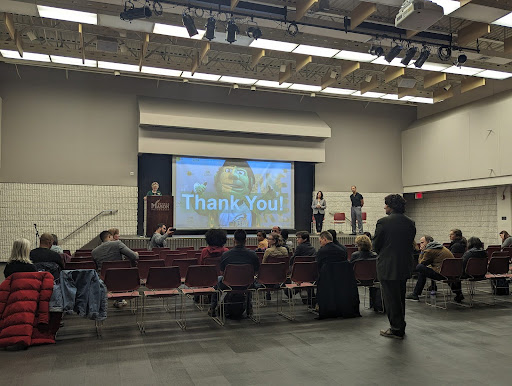Mason proposed a three percent increase for in-state tuition at the tuition town hall
BY VIVIANA SMITH, MANAGING EDITOR
In a Tuition Town Hall hosted by Mason Student Government on March 22, Mason administration proposed a 3% increase for in-state tuition for the 2025 and 2026 fiscal years due to funding shortfalls.
This makes for another academic year with a tuition cost increase. In 2022, there was a three percent increase in tuition, which was later reversed on Sept. 29 by the Board of Visitors.
In 2023, Mason proposed a $300 raise and a three percent increase in mandatory student fees. This proposal is set to increase tuition by an additional three percent.
In an Instagram post by Student Government, the Tuition Town Hall allowed “a chance to ask questions about student fees, tuition, and how your money is spent.”
Speakers Deb Dickenson, executive vice president of administration and finance, Rose Pascarell, vice president of university life, and Student Body President Paul Wyche presented the tuition information, breaking down the increases and explaining where student tuition dollars are spent.
Regarding the status of the commonwealth budget, Dickenson explains that the conference budget and governor’s budget are still in negotiation due to other projects requesting state funding, which increases financial disparities that affect Mason’s funding.
“Mason’s FY 2025 funding allocation, if it’s approved, is favorable,” Dickenson said. “It’s still below the amounts requested and we requested 18 million.”
The increase of tuition is intended to offset the financial gap caused by the decrease in state funding. “If we were to receive the full funding that we’ve requested from the state… we might not have to increase them out here [the tuition], we need the state’s commitments to that,” Dickenson said.
For out-of-state students, Pascarell explained the increase in tuition will not be similar to that of in-state students. “We moved away from a similar percentage increase for out-of-state students. It’s actually less than two percent. It’s like 1.6 [percent] for out-of-state students because we’re really trying to be conscious of the increases.”
Pascarell broke down the tuition dollar and how the money is distributed across the university areas that require funding. “84 cents on the dollar is spent on students, whether that is services or construction or academic support. You can see that overall 84 cents of every dollar is spent on students. And there’s an 11 cents shortfall. This is what the inequity looks like.”
According to the Office of the Executive Vice President, tuition funds university services such as academic instruction, academic support, operations and maintenance, institutional financial aid, institutional support and student services.
The proposal raised some questions among attendees, as some asked where the extra money was going.
During the question and answer portion of the town hall, one student asked for clarification on whether the entirety of that increased tuition is only going to strategic initiatives and contracts.
Dickenson said that the areas of tuition distribution and contracts will remain the same despite the increase. Additionally, she said the funding of strategic initiatives is not funded by students’ tuition dollars.
“Many of our strategic initiatives…. they’re often funded by our auxiliary operations, and other funding sources… most of the strategic initiatives are not funded through traditional tuition dollars,” Dickenson answered.
Dickinson later added that line item details about the fiscal year 2025 budget will be shared during a Board of Visitors meeting in May.
Wyche expanded on the student’s question to clarify if the increase in tuition amount could potentially lead to a decrease in the shortfall. “Obviously it’s going towards the level of shortfall, but do we potentially have the metrics to see… how much is the shortfall going to decrease after the projected tuition increase.”
Another student expressed concern regarding the FAFSA and whether the lack of funding for the university would affect student eligibility for financial aid.
“There is a new methodology for the federal government to determine need eligibility this year,” said David Burge, Vice President for Enrollment Management, who was in attendance. “[It’s] being replaced by something called the Student Aid index… we actually expect there to be more eligibility for things like pell [grants].”
The town hall opened conversation for students to ask about allocating the extra tuition to other programs at Mason, such as U-Pass, a free Metro pass program. Other students expressed their concerns for a hypothetical decrease in applicants at Mason and whether this would increase tuition once more for currently enrolled students.
According to Dickenson, the 2025 Fiscal Year budget will be presented during a BOV meeting on May 2.




